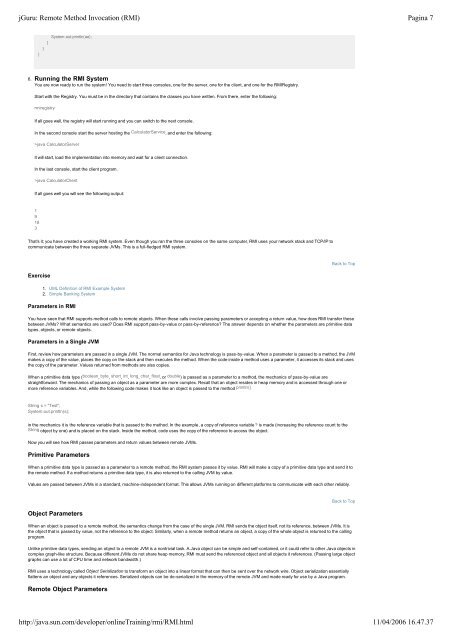jGuru: Remote Method Invocation (RMI) - Dse.disco.unimib.it
jGuru: Remote Method Invocation (RMI) - Dse.disco.unimib.it
jGuru: Remote Method Invocation (RMI) - Dse.disco.unimib.it
You also want an ePaper? Increase the reach of your titles
YUMPU automatically turns print PDFs into web optimized ePapers that Google loves.
<strong>jGuru</strong>: <strong>Remote</strong> <strong>Method</strong> <strong>Invocation</strong> (<strong>RMI</strong>)Pagina 7System.out.println(ae);}}}6. Running the <strong>RMI</strong> SystemYou are now ready to run the system! You need to start three consoles, one for the server, one for the client, and one for the <strong>RMI</strong>Registry.Start w<strong>it</strong>h the Registry. You must be in the directory that contains the classes you have wr<strong>it</strong>ten. From there, enter the following:rmiregistryIf all goes well, the registry will start running and you can sw<strong>it</strong>ch to the next console.In the second console start the server hosting the CalculatorService , and enter the following:>java CalculatorServerIt will start, load the implementation into memory and wa<strong>it</strong> for a client connection.In the last console, start the client program.>java CalculatorClientIf all goes well you will see the following output:19183That's <strong>it</strong>; you have created a working <strong>RMI</strong> system. Even though you ran the three consoles on the same computer, <strong>RMI</strong> uses your network stack and TCP/IP tocommunicate between the three separate JVMs. This is a full-fledged <strong>RMI</strong> system.ExerciseBack to Top1. UML Defin<strong>it</strong>ion of <strong>RMI</strong> Example System2. Simple Banking SystemParameters in <strong>RMI</strong>You have seen that <strong>RMI</strong> supports method calls to remote objects. When these calls involve passing parameters or accepting a return value, how does <strong>RMI</strong> transfer thesebetween JVMs? What semantics are used? Does <strong>RMI</strong> support pass-by-value or pass-by-reference? The answer depends on whether the parameters are prim<strong>it</strong>ive datatypes, objects, or remote objects.Parameters in a Single JVMFirst, review how parameters are passed in a single JVM. The normal semantics for Java technology is pass-by-value. When a parameter is passed to a method, the JVMmakes a copy of the value, places the copy on the stack and then executes the method. When the code inside a method uses a parameter, <strong>it</strong> accesses <strong>it</strong>s stack and usesthe copy of the parameter. Values returned from methods are also copies.When a prim<strong>it</strong>ive data type (boolean, byte, short, int, long, char, float, or double) is passed as a parameter to a method, the mechanics of pass-by-value arestraightforward. The mechanics of passing an object as a parameter are more complex. Recall that an object resides in heap memory and is accessed through one ormore reference variables. And, while the following code makes <strong>it</strong> look like an object is passed to the method println()String s = "Test";System.out.println(s);in the mechanics <strong>it</strong> is the reference variable that is passed to the method. In the example, a copy of reference variable s is made (increasing the reference count to theString object by one) and is placed on the stack. Inside the method, code uses the copy of the reference to access the object.Now you will see how <strong>RMI</strong> passes parameters and return values between remote JVMs.Prim<strong>it</strong>ive ParametersWhen a prim<strong>it</strong>ive data type is passed as a parameter to a remote method, the <strong>RMI</strong> system passes <strong>it</strong> by value. <strong>RMI</strong> will make a copy of a prim<strong>it</strong>ive data type and send <strong>it</strong> tothe remote method. If a method returns a prim<strong>it</strong>ive data type, <strong>it</strong> is also returned to the calling JVM by value.Values are passed between JVMs in a standard, machine-independent format. This allows JVMs running on different platforms to communicate w<strong>it</strong>h each other reliably.Object ParametersBack to TopWhen an object is passed to a remote method, the semantics change from the case of the single JVM. <strong>RMI</strong> sends the object <strong>it</strong>self, not <strong>it</strong>s reference, between JVMs. It isthe object that is passed by value, not the reference to the object. Similarly, when a remote method returns an object, a copy of the whole object is returned to the callingprogram.Unlike prim<strong>it</strong>ive data types, sending an object to a remote JVM is a nontrivial task. A Java object can be simple and self-contained, or <strong>it</strong> could refer to other Java objects incomplex graph-like structure. Because different JVMs do not share heap memory, <strong>RMI</strong> must send the referenced object and all objects <strong>it</strong> references. (Passing large objectgraphs can use a lot of CPU time and network bandwidth.)<strong>RMI</strong> uses a technology called Object Serialization to transform an object into a linear format that can then be sent over the network wire. Object serialization essentiallyflattens an object and any objects <strong>it</strong> references. Serialized objects can be de-serialized in the memory of the remote JVM and made ready for use by a Java program.<strong>Remote</strong> Object Parametershttp://java.sun.com/developer/onlineTraining/rmi/<strong>RMI</strong>.html11/04/2006 16.47.37
















